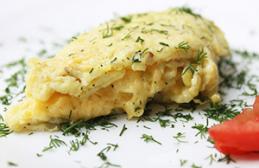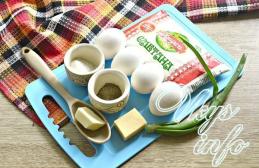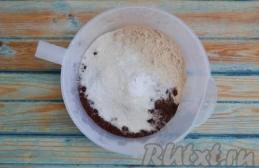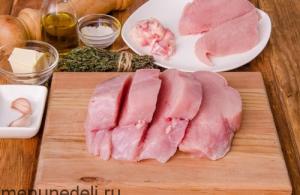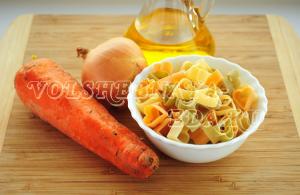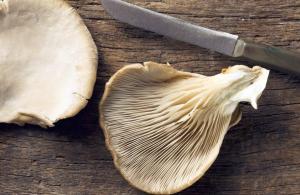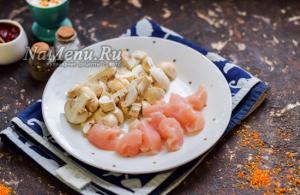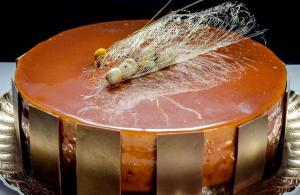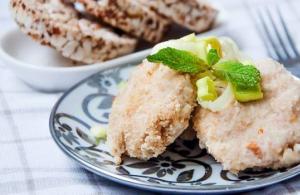It's hard to imagine life without sweets, the best of which are given to us by confectioners. Some recipes for their manufacture date back thousands of years, but continue to amaze with the novelty of nuances and freshness of impressions.
1. The first confectioners did not use sugar, since they did not yet know how to make it. But they actively used natural ingredients - dates and honey were the basis of sweets in Ancient Egypt, magic, nuts and honey were especially popular among the Romans, the Arabs preferred figs and almonds, and the Slavs preferred honey and molasses.

2. Chocolate in the 16th century became a popular delicacy, first in high society, and then quickly spread to other segments of the population. But for a long time, people believed that it had witchcraft powers, perhaps even evil ones, and then there were those who refused to even touch this devilish drink.

3. German scientists studied the relationship between character and filling preferences. It turned out that creative people love coconut filling, while romantics love strawberry filling. Shy people will prefer chocolate with nut filling, while decisive people, on the contrary, will choose cherry.

4. In the 19th century, Russia did not yet have its own candy factories, and then the creations of confectioners had to be ordered abroad. As a result, only the richest people could afford to decorate their party with a sweet delicacy created especially for the occasion.

5. In 1663, Jean Neuaus's recipe appeared, which over time became one of the most popular in Germany and Switzerland. He proposed making the filling for sweets from a mixture of sugar and roasted nuts and called this miracle praline.

6. At one of the many culinary shows, the confectioners from Master Food took first place, having built a box of chocolates 2.5 m long, 1.5 m wide and weighing 800 kg.

7. The largest candy in the world was created by confectioners from the Gummi Bear Factory. To cast a bear, 1.68 m tall, they needed a mold weighing 4 tons. The candy itself “pulled out” 633 kg.

8. When in 1995, astronauts asked for candy to be sent to the Mir station, scientists conducted serious research in search of the safest culinary delights. The winner was the lollipop, which was sent into orbit. So “round joy” became the only candy that has been in space.

9. The Finns turned out to be great originals. They are ready to snack even on beer with candy, and therefore products with a salty taste, with sour and even “petroleum” fillings are popular in the country.

10. Do you still remember the taste of Soviet “bird's milk”? Do you know what it’s made from, as well as marmalade, soufflé, marshmallows, etc. did you do? The main gelling component was agar-agar. This South Asian substance completely replaces gelatin. It is made from sea brown and red algae after special processing. The result is an amazing substance that dissolves when heated strongly and turns into a gel at a temperature of 30-40C. By the way, it is widely used in microbiology to create nutrient media.
We receive many letters with reviews, gratitude, impressions, and joy about participating in the gingerbread program. But one of them became a little special. The man shared his story, his feelings - deeply and sincerely.
We hope you enjoy the essays of one of our students, or rather now a graduate.
- Expectation.
You know how it happens... everyday life, monotony, a pattern... And then you decide on something and everything changes, and you don’t sleep at night, in anticipation of when the long-awaited date will come, when there will be a beginning.
This is exactly how I felt before the start of the “Gingerbread Master” program on gingerbread art. The night before the first class I hardly slept, and time moved so slowly. And this night turned out to be the first among sleepless, delicious nights, saturated with the aroma of cinnamon and cardamom, clear lines and tenderness of colors...
Like many, before this program, I watched the video course “Gingerbread from A to Z” and it hooked me. This course showed that everything is possible, take it and do it - simple, beautiful, easy. The process was fascinating, the result pleased me and my family. And, of course, I wanted more. I wanted to try other dough recipes, learn the secrets of decoration, and I just wanted joy, warmth and light, and I found all this.
The business that captivates us makes us stronger, better, makes us ourselves.
- Magic.
Sometimes magic begins with a simple, beautiful and clean kitchen. Perhaps many have not noticed this, but it is so important when there is nothing distracting, when everything is clear and accessible. As they say, “beauty is when there is nothing superfluous.”
Each gingerbread dough plays on its own notes, and tactile sensations make you understand the melody: honey - foamy, airy, when you knead it, you stand on your toes, you want to fly, goat - viscous, cool, here the organ and pipes play in the background, and the dough is according to the recipe Julia Asher's style can be described as light, modern and slightly jazzy.
Magic, elusive magic.
Here you are given a set of ingredients, the same set, and step-by-step instructions for use, but the result is always different. The process of preparing gingerbread goat dough is mesmerizing: the spices intoxicate your head with their aroma, the sugar, during the caramelization process, turns on the “you want to eat something sweet” function, when you add boiling water, your heart skips a beat, and how happy the eye is when the soda works its miracles, turning the aromatic mass into double foamy pleasure . You knead the dough and think - what will it be like? This magical process combines everything - mood, ingredients, expectations, thoughts, lunar phases, cosmic energy. And in the end, the dough is always a little special, different, unique: sometimes light and light, sometimes dark and caramel, but always incredibly tasty. Elena said that goat dough brings happiness.
Checked! I have a lot of happiness in my house now)

- Doubt.
I want to do everything at once, and a lot, and more, and longer. No sleeping, no eating, just baking gingerbread and making icing. This “wanting” comes after doubt: can I? You will look at the incredibly beautiful gingerbread cookies, and then at your crooked ones and again in doubt. Oh, they, oh, these doubts are blockers of happiness. Away! You just need to step over, and the main thing is to do - the first, second, fifth, seventh, tenth gingerbread and now an excellent result.
And you also have doubts when choosing equipment for a gingerbread maker, because you want to buy a lot, everything seems necessary and necessary. The goods market offers a lot of cuttings, nozzles, dyes, stamps, etc., but it turns out that most of this is unnecessary, or inconvenient to use, or short-lived, and many thanks to Elena for explaining everything and showing everything, and also reducing costs).
Doubts persist when submitting homework photos. Everything seems clumsy and awkward. Only the support of other students in the Facebook group saves me. Thank you for the responsiveness and activity of all the school students: the “old ones” show where we need to strive, and the new ones delight us with their diligence and zeal.
We are all learning, we are developing, we are not standing still - this is important, and how can you be ashamed of this?

- To family and loved ones.
After taking a class on different techniques for painting gingerbread, you begin to be amazed at the simplicity of creating masterpieces. Probably, everything ingenious is really simple. Favorite techniques appear, they somehow define themselves. And when preparing and decorating gingerbread, you begin to think about the person to whom you want to give this particular gingerbread. Mom will like “lace”, and uncle will make a “stamp”; the nieces, of course, will each have a bear in the “volumetric fill”, but our beloved grandmother will get a heart in the “stitch” style.
Working with icing is a little crazy. Glaze loves a counting rhyme, and only by counting can you understand what it is ready for: to be a base, or a filling, or maybe become a queen of three-dimensional figures. Now it’s clear why they call her “royal” - she’s capricious. You just need to make friends, let her rest under a damp towel and she will answer you with her generosity and beauty.
There are still so many new things ahead, so many discoveries, ideas, ideas, and it’s so nice to walk along this gingerbread path!



- Opening up horizons.
After the third lesson, you begin to believe in yourself and your strengths, you see what beauty you have created, how it surprises your family and friends, and it surprises you too, and now you want more.
Are you ready, are you confident, you can conquer new horizons!
The hand is already confidently drawing a contour line, the eye can easily determine how much water needs to be added to dilute the glaze to the desired consistency, the heart beats the rhythm of the required scales.
Gingerbread card! This is the art of patience and the interweaving of lines. And this is also the work of a jeweler: dots and lines, buds and petals, roses and leaves - and all this is subtle and without room for error.
3D shapes! It's like creating a cartoon. The imagination does not draw strict forms here, but only cheerful, perky and bright.
This is how you do something, do a lot, and suddenly you realize that your Love is 3D gingerbread shapes.
A fungus is a home for little forest dwellers, and a family of hares immediately makes you fall in love with their fluffy tails). And then the thought came - urgently to make other families of animals: foxes, bears, hedgehogs... thoughts put together the stages of work, and imagination completes the result.
Definitely! It is mine!



- My little dream house.
Many people dream of their own home, and so do I. For a long time. A dream is a picture that you create in detail and strive for. What will my home be like? Light, kind, big, rainbow, with flowers and berries, currant and raspberry bushes, the aroma of happiness. And when creating a Gingerbread House, you begin to think about your big one. The color of the roof, the balcony, the smooth walls, the door, the window - how beautiful.
This is real construction! A small construction project where every detail is important: process all the walls, sharpen and check that they fit together perfectly, clear them of sweet grains, weld glass from caramel - mmm..., and you understand that this is already a dream from childhood - to live in sweets home that you can eat.
You tenderly fill the walls with pastel glaze, make a lawn and a path, patiently cover the roof with tiles, the chimney with bricks, and suddenly - a balcony.
Sometimes your ideas about how it's done are simply opposite. You can’t believe that it’s possible just like that – a balcony made of glaze and not a drop of dough.
You understand that every detail of the house requires its own special attention and attitude, a personal approach. You make a door and hear it begin to creak a little when nails and a handle appear on it.
And here it is my house! So amazing and so uncollected. My breath freezes from excitement, my hands tremble a little... Calm, only calm. And now there is a result that pleases.
A little crooked, my first, my dear gingerbread house!
And one thought - I won’t let anyone eat it.
And after a few days you quietly burst the flowerpot)))

Modern confectionery art was formed thanks to centuries of experiments by amateurs and professionals, dreamers and innovators who poured their souls into sweet creations. And although our main goal is to select the optimal culinary school for you and organize admission, today we are pursuing an educational mission. How? We expand your horizons by telling you about incredible facts related to the art of confectionery. After reading, you will definitely be inspired to prepare a dessert with a twist.
It all started in Egypt
Did you know that the first masters of confectionery art appeared not in France, but in Egypt? Until the 7th century, European sweet tooths were content with fruits in various forms, eating them fresh and dried. But the Egyptians actively experimented and pampered themselves with delicious desserts made from honey, spices, seeds, grains and sweet fruits. The Muslim invasion in the 7th century allowed the delicacies to migrate to Europe, where a confectionery frenzy literally began.
Italian origin
However, for several centuries the Arabs maintained a “monopoly” on sweets. The fact is that they knew and used sugar since 850, and Europeans put it into circulation only at the end of the 15th century. It was from this time that active development began, the center of which was Venice. The word “confectioner” itself comes from the Italian verb “candiere,” which meant “to cook in sugar.” By that time, the Latin word “confectioner”, i.e. cook, was in use. As a result of accidental confusion, in the 18th century Europeans began to call everyone who knew how to prepare sweets “confectioners.”
The secret past of pasta
A few years ago, the traditional French dessert macaron took the whole world by storm. A delicious sweet made from protein, sugar and ground almonds that literally melts in your mouth and captivates with its variety of flavors. And while everything is clear about the public’s love for pasta, his past is vague. The gastronomic encyclopedia Larousse dates the origins of this dessert to Venice and the Renaissance. Many believe that pasta was first prepared in France in Cormery several centuries earlier. The third version says that the delicacy was brought from Italy after 1560.
We don't have a time machine to solve this mystery, but we do know that you can learn how to cook the perfect pasta at a culinary and pastry school. For details about programs and tuition fees, contact STUDIES&CAREERS consultants in any of the convenient ways.
Exact science
From the first classes, students of confectionery schools understand that the “sweet business” is an exact science where proportions, temperature and cooking time cannot be neglected. Following the recipe is the success of any dessert. Thus, the pastry direction is recognized as one of the most difficult in cooking.
Chocolate River
We are sure that you have watched the colorful film “Charlie and the Chocolate Factory”. Remember the huge river that flowed through the kingdom of the main character? Yes, yes, we are talking about an endless stream of chocolate. Let's reveal a secret, this river was “made” from real chocolate with the addition of 500 liters of water and cream.

Polish dessert in France
In the wonderful 50s, a Polish pastry chef, Alexander Mika, worked in Saint-Tropez and owned a pastry shop. One fine day he put on the counter a dessert made according to the recipe of his beloved grandmother. The treat was a sugar brioche cut into two pieces, filled with custard and whipped cream. 5 years later, Roger Vadim and his team came to the French Riviera to film the film “And God Created Woman.” By a lucky coincidence, it was Alexander who was in charge of catering, treating the actors with delicious delicacies. The main performer of the film, Brigitte Bardot, was amazed by the Polish dessert and gave it the name “La Tarte Tropezienne”, i.e. Tarte Tropezien.

For details on where you can learn to become a pastry chef, check with the STUDIES&CAREERS specialists.
For knowledge and entertainment, we have prepared for you 9 interesting facts about the art of confectionery, which will definitely inspire you to new delicious achievements!
No. 1. Thank you Egyptians
It turns out that confectionery products were first imported into Europe during the Muslim invasion back in the 7th century - before that, unspoiled Europeans delighted themselves only with fruit, fresh or dry. The idea of sweet treats immediately captured the minds of the culinary maestro, and they began to create tirelessly. The first, however, were and remain the Egyptians, who prepared delicious desserts from a mixture of honey, fruits, spices, various seeds and grains.
No. 2. Si, Senor Candiere!
Did you know that if history had turned out a little differently, the word “confectioner” could have sounded completely different, for example, “cucumber maker” or “marshmeller”? The word "confectioner" comes from the Italian verb "candiere", which means "to cook in sugar". It was from this, from our irreplaceable sugar, that the confectionery business began in Europe, or more precisely in Italian Venice, where it received the most rapid development by the end of the 15th - beginning of the 16th centuries.
The main rule of confectionery art is maintaining proportions. Only those who have devoted one or two years to practice can afford such a luxury as measuring “by eye”. In confectionery, you need to carefully monitor cooking temperatures and follow recipes exactly. One small inaccuracy - and goodbye, reputation! That is why the pastry direction is considered the most difficult in cooking and is an order of magnitude ahead of gastronomic skills, where imagination and improvisation often become synonymous with professional victories.
No. 4. You're not French!
Years have passed and now it’s out of the blue! After everything we have experienced and baked, it turns out that the croissant was invented not in France, but in Austria! There is even a legend in confectionery chronicles according to which, in 1683, Viennese baker Peter Wendler prepared the first croissant in honor of the failure of the Turkish siege of Vienna. One day, the bakers of the confectionery, working at night and preparing fresh buns for the townspeople in the morning, heard a suspicious noise from hoes and picks. They realized that the city was being attacked - the Turks were digging under its walls. Having warned the soldiers about this in time, they thwarted the plan of the Ottoman army and saved Vienna. This is the first real story of rejoicing and the victory of confectionery art over bloodthirsty conquerors!

No. 5. At least one more piece
Have you imagined yourself at least once as a taster, for example, a judge of an international competition, where you need to taste the products of the competitors for several days? They may be tasteless, overly spicy, special and simply unbearable - but the task remains the same. You must understand the textures, flavor combinations of at least 30 desserts a day and give your strict verdict. During this difficult period, the maestros try to eat the bare minimum outside the competition arena, and also never finish a single dessert, even if it is fabulously divine!
No. 6. Willy Wonka's Suspicious River
Did you know that the delicious chocolate river in the movie Charlie and the Chocolate Factory was actually made of chocolate and consisted of over 500 liters of water mixed with cream and chocolate! The creators of the sweet miracle admitted that the freshness of the reservoir did not last long and did not cause any appetite afterward.

No. 7. Don't cook my favorite pasta
Our favorite macaroons, in their final role as we know them, were invented by the famous French patisserie Laduree, which still exists today, famous for the same macarons and continues to open its luxurious sweet salons throughout Europe. Plain macaroons, without colors or fillings, became famous thanks to the sister nuns who baked them to survive the French Revolution of the late 18th century.

At the turn of the 1900s, the successful entrepreneur and Laduree master, Pierre Desfontaines, remembered pasta. He decided to combine the macaron halves with ganache (a flavored cream based on fresh cream, chocolate and butter). Having avoided the sad fate of ordinary macaroons, macaron has become a pleasure product, with a thin crispy crust, soft almond meringue and velvety filling.
No. 8. Cronuts exist
In 2013, American pastry chef Dominique Ansel made a new confectionery breakthrough and invented a cross between a croissant and a donut (donuts), which received the awesome name of cronuts! For some time, a real “Cronuts epidemic” reigned in New York - incredible queues of many kilometers lined up at Ansel’s confectionery shops!

No. 9. Favorite dessert of the Cote d'Azur
Did you know that the most popular and colorful dessert in Saint-Tropez, one of the most famous towns on the French Riviera, is Tarte Tropezien, a nutritious treat based on sugar brioche, cut in half, filled with custard and whipped cream. A treat for real sweet tooths appeared in Saint-Tropez in the 50s, when the Polish emigrant pastry chef Alexander Mika offered a dessert based on his grandmother’s recipe in his own pastry shop.

Popularity came 5 years later during the filming of the film “Et Dieu” by Roger Vadim. Alexander prepared catering for the actors and the dessert captivated their hearts and stomachs forever. Brigitte Bardot was also delighted, and gave the dessert the name “Tarte Tropezien.”
To be continued…
We are used to buying many confectionery products in the store. This often turns out to be more convenient than making them yourself. But, as a rule, the range of industrial confectionery products is stable. These are primarily candies - chocolate, caramel and marmalade, then dry cookies, waffles, gingerbread and biscuit products - cakes, biscuits, cakes. Local food factories (and not confectionery factories!) usually produce different (in name and shape) products from the same - shortbread, puff pastry or gingerbread-sugar dough (from shortcakes to cakes), less common are cookies made from butter dough and muffins from Easter cakes, as well as oriental sweets themselves, various halva, Turkish delight, nut products (nougat, kozinaki, churchkhela, sugared nuts), usually produced only by local poultry processing plants of the Union republics of Transcaucasia and Central Asia.
The constancy of this set is explained both by the characteristics of large confectionery production, focused on the production of a certain type of product, and by the conditions of mass marketing. The industry produces only those confectionery products that can withstand transportation and long-term storage in a warehouse and, in addition, are adapted for machine-factory production, for production in large standard quantities. But there are not so many such products. Most of the works of confectionery art are designed to be served to the table almost straight from the oven, in any case, eaten on the same day or within two days.
These are, for example, confectionery products made from cottage cheese, cottage cheese cakes and pastries, Viennese muffins with whipped cream, pies made from Viennese puff pastry with poppy seeds and jam, creamy toffees, a variety of fondants, apple and quince pie-pies, fruit and egg cakes, French and Spanish wind, etc., etc.
In addition, a number of confectionery products cannot be adapted to mechanized production, and they still have to be made by hand, and this leads to the fact that their circulation is insignificant and they quickly become scarce. These are, for example, liqueur candies. That is why home-made confectionery preparation, if it does not duplicate industrial preparation, is completely justified and advisable.
However, due to the fact that the traditions of home confectionery production were interrupted during the war and in the first post-war years, the younger generation does not even know about the existence of many simple, easy-to-make and affordable home-made confectionery products, and even less so on how to make them.
In this chapter we will focus on the production of only a few such confectionery products, because a story about all or most would require a separate book, since this is a special science, with its own laws, methods and techniques that differ from those of a chef.
Therefore, from time immemorial, a pastry chef and a cook were different professions that sometimes required different qualities and talents. So, for example, in Italy and France, people who knew how to draw well were accepted as confectioners, and during the training process they were taught a course in the history of architecture and art history, taught drawing, ornamentation, sketching, modeling - subjects that seemed far from the kitchen craft. While the cooks studied zoology, botany, animal anatomy and thus stood closer to the students of natural biology faculties.
So that our story about the confectionery business does not come down to listing recipes that require absolutely precise execution, we will preface them with a general, very brief overview of the confectionery business. Only then will the reader be able to clearly imagine what a pastry chef should be doing, what he should be able to do, what his responsibilities are and what part of his skill we can show in this short chapter.
All confectionery business is based on three main processes:
1. Cooking sugar and sugar-like media - molasses and honey.
2. Baking confectionery products containing and not containing flour.
3. Preparation and casting of various fillings and mixtures of chocolate, praline and marzipan type, as well as the production of creamy egg type creams.
All other processes are either of an auxiliary mechanical nature, or are combinations and combinations of those listed above.
In accordance with these basic processes, confectionery production itself is divided into caramel-marmalade, chocolate and cake (including cookies), and usually each of them is handled by a separate factory. In a household, such a strict division cannot be made. The housewife has to be a jack of all trades, and therefore the home pastry chef, willy-nilly, must understand all the processes, or at least understand their essence.
The boiling of sugar, molasses, honey and everything that can be boiled in them, with them and on them, is the most characteristic feature of the confectionery business.
The word “confectioner” comes from the Italian verb “candiere,” which means “to cook in sugar.” Only the coincidence with this verb of the Latin word “conditor” - a master who prepares food, who knows how to give it taste - as the Romans called cooks, explains the fact that in Europe in the 18th century they mistakenly began to call sweet makers not candirs, but confectioners, or confectioners, for by this time each nation had long been calling cooks not by a borrowed foreign name, but by their own national name: Russians - cook (the person who cooks, cooks), the Germans - koch (the one with whom everything is boiled, boils), the French - culinary specialist, or chef de cousin (head of the kitchen, master of the kitchen), Italians - cuocco (boil, fry something on the fire).
The art of confectionery itself arose and received its greatest development in Italy, in Venice, only with the advent of sugar at the end of the 15th - beginning of the 16th centuries. Until then, sweets in Europe were bought from the Arabs, the most ancient confectioners in the world, who knew sugar since 850. It is no coincidence that in the East, in Arab countries and Iran, the most diverse sweets in the world are still created. While in Europe the confectionery business was developing in the direction of cakes and cookies, the Arabs were the first to notice that boiling (or melting) sugar - canding - opens up wide opportunities for preparing a variety of sweet, dessert, confectionery products and dishes.
The first products that began to be boiled in sugar were the juices of berries and fruits and the berries and fruits themselves. For some peoples, they are ground and turned into puree, for others they are only crushed, for others they are whole. This is how syrups, marmalades, jams, figs, jams, marmalades, Russian jams, Ukrainian dry jams and Transcaucasian candied fruits appeared.
Cooking sugar by itself, in its pure form, or with minor additions of dyes, spices, nuts, poppy seeds, butter, milk and cream, or grape wine, brought to varying degrees of thickness, also produced (especially in the East) a whole range of confectionery products: candies , novot, lean sugar, sweets, toffees, toffee, grilled vegetables, caramel, nogul, etc.
As soon as a new food product was introduced into the same boiling sugar - starch, flour or dragants (glutinous, glue-like natural plant media - gum arabic, soap root, yantak, etc.), a new family of confectionery products arose - halva, nougat, alvitsa, turkish Turkish delight, etc., etc.
Even frying dough products in melted sugar or honey produced unique sweet confectionery products - chak-chak, pumpernickels, pipercocks, honey custard gingerbreads, teiglahs, bagardzhi, baklava, etc.
In a word, sugar and its companions, molasses and honey, were the foundation on which and with the help of which confectionery skills began to develop.
Moreover, it was noticed that sugar has its own laws of boiling, melting, viscousness, fragility, etc. and that its behavior in a hot molten state can be even more insidious than the behavior of butter. Therefore, in order to master confectionery, you should first of all study the methods of cooking sugar and its different states during cooking, otherwise it is impossible to competently prepare a single confectionery product.
There is a sugar scale and a special sugar thermometer, with which you can accurately determine the degree of density of sugar at any moment and, depending on this, stop or continue cooking syrup, jam, caramel, fudge, etc.
But in households, the readiness of sugar syrup is determined by characteristic external signs, which confectioners call “samples.” There are twelve “tests” in total. Each of them has not only a number, but also its own name, a name that is usually given without any explanation in culinary and confectionery books.
Here's what these samples mean:
1. Liquid syrup(15° on a sugar thermometer).
This syrup has no stickiness, its thickness and sugar content is almost unnoticeable. It is used for pouring winter compotes and dried fruit compotes, sometimes for light sorbets (a mixture of hot syrup and fruit juice).
2. Thin thread(33° on a sugar thermometer). A sticky syrup that, when squeezing and unclenching one drop with your fingers, produces a thin, quickly breaking, fragile thread. Used for jam from dense, hard fruits - pears, quinces; dense apples, carrots, and sometimes for pouring winter compotes from soft berries (strawberries, raspberries), for making jelly.
3. Middle thread(approximately 40° on a sugar thermometer).
The thread is thin, but holds a little stronger. Syrup of this strength is used for jam.
4. Thick thread.
A thick syrup in which the fingers are separated with force, forming a strong and rather thick thread that can harden. Used for all jams made from tender berries and for canning most berries and fruits.
5. Weak fondant.
If you put a small amount of such melted sugar in a glass of cold water, a loose mass is formed, reminiscent of thick sour cream in consistency. This test is a sign that you need to be prepared for the sugar to thicken until the next test. It has no independent meaning.
6. Fudge.
If you drop such melted sugar into a glass of cold water, the “drop” solidifies into a piece similar in consistency to thick butter. This sample is very unstable and can quickly go into the next one, therefore, if this is what the recipe calls for, then you must immediately stop the boiling of the sugar. Used for making fudge and candy fillings.
7. weak ball(semi-hard ball).
Sugar in cold water hardens to the consistency of bread crumb. You can mold it into a soft, pliable ball. Used for fondants, toffees, candy fillings, candied fruit jams, figs, and sometimes for gingerbread (when mixed with honey and flour).
8. hard ball(or a strong ball). Boiling sugar in a glass of cold water hardens into a dense, hard ball, which after a while loses its ability to wrinkle. This sample is used exclusively for sweets, toffees, and toffees.
9. Crack.
Testing the sample is done like this: take boiling sugar on a fork and blow on it with all your might. If the sugar instantly turns into a film or bubble and flies off the fork entirely, then the “crack” sample is ready.
Used for meringue cookies, cakes, decorations and candies.
10. Caramel.
Boiling sugar poured into cold water should form a piece, an icicle, that does not stick to the teeth and crumbles into crystals like glass when pressed or hit. Sugar of this standard is used for caramels - sweets, lollipops, montpensiers.
11. Bypass.
The fragility of sugar is the same as in sample No. 10, but the color of the sugar is already yellowish-brown. Very often, this particular test - bypass - is mistaken for caramel, since in many confectionery books and manuals the term “sugar is caramelized” is used, which means yellowing and even slight burning of sugar, its browning and the appearance of a characteristic “caramelized” smell as a result of the bypass (bypass) actual caramel sample.
The transfer is used for some lollipops, caramel candies, and especially for grilling, as well as for coloring many confectionery products, drinks (including beer) and creams or giving them a special, “caramelized” aroma (for example, punch, burnt liquor).

12. Combustion. Zhenka.
The sugar turns brown, and an acrid smoke and burnt smell appears. This sugar is diluted with boiling water to form a sticky syrup and is used for tinting sweets, candy fillings, gingerbreads, icing, kvass, creme brulee ice cream, pastries, pies, various drinks and even some soups - beer, bread, egg, berry or sweet milk.
To go through all these stages and see how sugar behaves in practice, it is advisable to take 400 - 450 grams of sugar and, diluting it in half a liter of water (500 milliliters), put it on high heat. As soon as the syrup boils and the foam is removed from it, you will get sample No. 1. Further evaporation of the water will make it possible to clearly see the transition of the remaining samples from one to another.
With samples No. 5 and 6, the amount of water will be reduced by half - to 240 - 250 milliliters per 400 grams of sugar.
Cooking sugar has other rules.
Firstly, sugar should always be cleared of foam before other products are dipped into it.
To make it easier to remove the foam (confectioners call it “noise”, spoiled from the German word “shaum” - foam), in the confectionery business it is always customary to cook not with granulated sugar, but with refined sugar or crushed sugar.
Secondly, when sugar is put into water, it must be stirred all the time so that it does not stick to the bottom and does not give a yellow color to the entire syrup. But as soon as the sugar dissolves in the water, the syrup can no longer be touched, you cannot stir it, you cannot lower any object, because this will cause the syrup to crystallize, become cloudy, or even form lumps in it.
Thirdly, as soon as the foam is removed, you need to use a special cloth soaked in ice water to wash the edges of the dishes so that not a single grain of sugar remains on them. This technique is the main secret in handling boiling sugar. If the operation is carried out carefully, the product will turn out much better. Otherwise, the sugar will begin to build up at the edges, boil, burn, or turn into a lump inside the pelvis, before even reaching the 6th or 7th sample.
Fourthly, sugar syrups should always be cooked over high, even heat, avoiding fluctuations.
Fifthly, sugar and products made from it must be boiled either in a thick-walled metal container with a convex bottom (hemispherical cauldron), or in special brass or copper basins, where both the shape and material are most suitable for sugar brewing.
Sixth, in dry confectionery mixtures, in dough, in drinks and in cakes, it is best to use grated, crushed sugar or special confectionery (the so-called “tambourine”) powdered sugar. Granulated sugar is not used in confectionery as a product that contains impurities and produces a syrup of weak concentration.
Proper handling of sugar is the key to success in making not only jam at home, but also simple dairy and creamy confectionery products: fudge, toffee, grilled bread.

